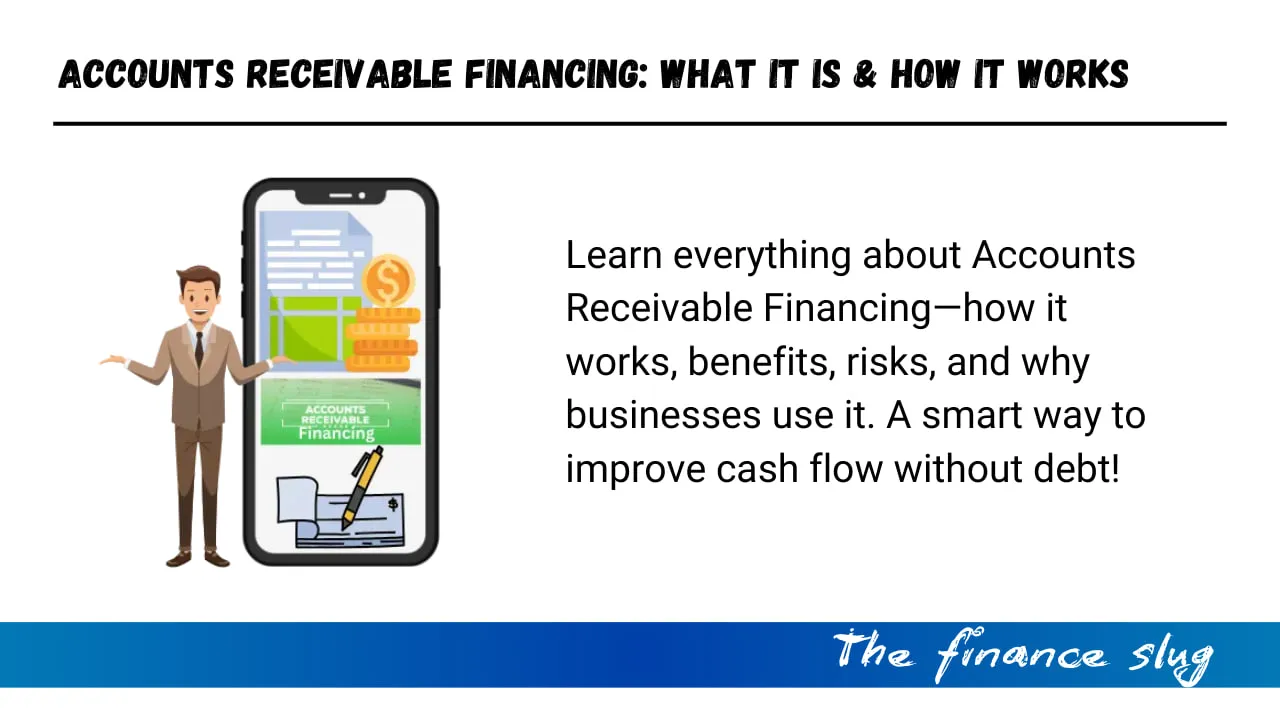
- What is Accounts Receivable Financing?
- How Does Accounts Receivable Financing Work?
- Types of Accounts Receivable Financing
- Benefits of Accounts Receivable Financing
- Potential Risks of Accounts Receivable Financing
- Accounts Receivable Financing vs. Traditional Business Loans
- Who Should Consider Accounts Receivable Financing?
- How to Choose the Best Accounts Receivable Financing Provider
- Final Thoughts
- Frequently Asked Questions (FAQs)
What is Accounts Receivable Financing?
Accounts Receivable Financing (AR Financing) is a funding method where businesses use unpaid invoices as collateral to obtain cash. Instead of waiting for customers to pay their invoices, companies can receive immediate cash from a lender or financing company. This type of financing helps businesses maintain steady cash flow without taking on traditional debt.
How Does Accounts Receivable Financing Work?
AR Financing typically involves three parties:
- The Business (You) – The company that owns unpaid invoices.
- The Financing Company (Lender) – The entity that provides cash based on outstanding invoices.
- The Customer (Debtor) – The client responsible for paying the invoice.
Step-by-Step Process:
- Issue Invoices: The business provides goods or services and issues invoices to customers.
- Apply for Financing: The business submits invoices to a financing company for approval.
- Receive Cash Advance: The lender advances a percentage (typically 70-90%) of the invoice value.
- Customer Pays Invoice: The customer eventually pays the invoice amount.
- Final Payment Settlement: Once the customer pays, the financing company releases the remaining funds (minus fees).
Types of Accounts Receivable Financing
There are two main types of AR financing:
1. Invoice Factoring
- The business sells invoices to a factoring company.
- The factoring company takes responsibility for collecting payments.
- A quick way to receive cash, but usually more expensive.
2. Invoice Discounting
- The business retains control of invoice collection.
- Uses invoices as collateral to receive a loan.
- Less expensive but requires strong customer relationships.
Benefits of Accounts Receivable Financing
✅ Improved Cash Flow
Businesses get cash immediately instead of waiting 30-90 days for customer payments.
✅ No Additional Debt
Unlike traditional loans, AR financing doesn’t add liabilities to your balance sheet.
✅ Fast & Easy Approval
Lenders focus on invoice quality, not credit scores, making approval quicker than bank loans.
✅ Flexible Financing
The more invoices you generate, the more financing you can access.
✅ Supports Business Growth
With steady cash flow, businesses can invest in new projects, inventory, and expansion.
Potential Risks of Accounts Receivable Financing
❌ Higher Costs
Factoring fees and interest rates may be higher compared to traditional loans.
❌ Customer Dependence
Approval and funding depend on the creditworthiness of your customers.
❌ Loss of Control (in Factoring)
If you choose invoice factoring, the lender collects payments, which may affect customer relationships.
❌ Not Suitable for All Businesses
Companies with low invoice volume or inconsistent sales may not qualify.
Accounts Receivable Financing vs. Traditional Business Loans
| Feature | AR Financing | Traditional Loan |
|---|---|---|
| Collateral | Unpaid invoices | Business assets |
| Speed of Approval | Fast (1-5 days) | Slow (weeks-months) |
| Debt Involvement | No debt added | Increases business debt |
| Customer Credit Impact | Based on customer creditworthiness | Based on business creditworthiness |
| Flexibility | Scales with sales | Fixed loan amount |
Who Should Consider Accounts Receivable Financing?
This financing option is ideal for:
- Small and medium-sized businesses needing quick cash.
- Companies with long invoice payment terms (30-90 days).
- Businesses with strong B2B sales and reliable customers.
- Companies struggling with seasonal cash flow gaps.
How to Choose the Best Accounts Receivable Financing Provider
When selecting a financing company, consider:
✔️ Reputation & Reviews – Look for providers with strong customer feedback.
✔️ Fees & Interest Rates – Compare costs to ensure affordability.
✔️ Advance Rate – Higher advance rates mean more immediate cash.
✔️ Customer Service – Responsive and transparent lenders are best.
✔️ Collection Process – Choose factoring companies that handle customer payments professionally.
Final Thoughts
Accounts Receivable Financing is a smart cash flow solution for businesses that deal with delayed customer payments. While it has some risks, its benefits – such as fast funding, no additional debt, and flexible financing – make it an attractive alternative to traditional loans. If your business needs immediate cash to sustain operations or expand, AR financing might be the right fit for you.
Also Read : What is Accounts Receivable (AR)? Definition, Examples & Best Practices
Frequently Asked Questions (FAQs)
1. Is Accounts Receivable Financing the same as a loan?
No. AR financing is not a loan—it’s an advance based on unpaid invoices. Unlike traditional loans, it doesn’t add debt to your balance sheet.
2. What industries commonly use AR financing?
Industries like manufacturing, staffing agencies, healthcare, transportation, and wholesale trade often use AR financing to manage cash flow.
3. How much does Accounts Receivable Financing cost?
Costs vary based on factors like invoice value, industry, and financing provider. Expect fees ranging from 1-5% per month.
4. Can startups qualify for AR financing?
Yes, as long as they generate invoices for creditworthy customers. Lenders evaluate customer payment history, not just the business’s financials.
5. What happens if a customer doesn’t pay the invoice?
In recourse financing, the business is responsible for unpaid invoices. In non-recourse financing, the lender absorbs the loss but charges higher fees.
Stock Market Crash Today: A Bloodbath on Monday – What You Need to Know
Published on financeslug.xyz The global financial markets are reeling from a massive sell-off, and Indian…
Wall Street Bonuses Reach Record $47.5 Billion in 2024, Up 34% from Previous Year
How to Convert Delimited CSV Data into Columns in Excel
CSV (Comma-Separated Values) files are widely used for data exchange, but when opened in Excel,…
Harvard University Announces Free Tuition for Families Earning $200K or Less
Harvard’s New Tuition-Free Policy: What You Need to Know Harvard University has unveiled a groundbreaking…
Eli Lilly’s 1.8B Dollar Investment in Weight Loss Drugs
Ireland’s Weight-Loss Drug Boom: A Game-Changer for Economy and Healthcare Ireland is witnessing a surge…
Forever 21 Files for Bankruptcy Again: The End of an Era in Fast Fashion?
Forever 21, once a staple in American malls and a leader in the fast-fashion industry,…







